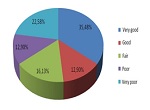
GAP ANALYSIS IN DELI WATERSHED MANAGEMENT MEASURED BY STAKEHOLDERS’ SOCIAL FACTORS DELI NORTH SUMATERA
Abstract
A watershed is an area encompassing rivers and tributaries, which functions as a container, a reservoir, a water drainage system, and a home for human activities and other living things, either living on the banks of the river or living in a watershed. This research is a qualitative descriptive study that used interviews and questionnaires to collect the data. This study examined four main factors in Deli Watershed Management: stakeholders' capacity level, knowledge levels, attitudes, and the gap in watershed management. The t-test result showed the correlation's capacity level as an insignificant variable (p> 0.05). The regression model that describes the correlation between stakeholders' knowledge level, stakeholders' attitudes, simultaneously, and the gap in the management of the Deli Watershed Management amounting to y = 1.164 - 0.173 x1 - 0.470x2 where x1 = level of knowledge and x2 = attitudes. The value of r = 0.704 indicates that the correlations between these variables are strong. Meanwhile, the adjusted R square value is 0.460. The F-test suggests that 46% of the variation in the gap in the Deli Watershed Management was due to stakeholders' knowledge levels and attitudes in implementing the management. Thus, social inequality in watershed management correlates with stakeholders' knowledge and perspectives. Still, it does not have an accurate correlation with stakeholders' attitudes.
Keywords: Watershed, Deli, Management, Gap Analysis, Correlation
Full Text:
PDFReferences
Ahn, S. R., & Kim, S. J. (2017). Assessment of integrated watershed health based on the natural environment, hydrology, water quality, and aquatic ecology. Hydrology and Earth System Sciences, 21(11), 5583-5602.
Amalia, G. R. (2013). Peran stakeholder dalam implementasi kebijakan pengendalian pencemaran air sungai di Kota Surabaya. Media Jurnal Politik Muda, 2(2), 65-71.
Anggraeni, D. (2017). Sistem informasi pengelolaan daerah aliran sungai di bpdas kota padang. JURTEKSI (Jurnal Teknologi dan Sistem Informasi), 4(1), 29-36.
Aprianty, H., & Triyanto, D. (2018). Implementasi Good Enviromental Governance dalam Pengelolaan Daerah Aliran Sungai (Das) Bengkulu. JIP (Jurnal Ilmu Pemerintahan): Kajian Ilmu Pemerintahan dan Politik Daerah, 3(2), 136-148.
Aprianty, H., & Triyanto, D. (2018). Implementasi Good Enviromental Governance dalam Pengelolaan Daerah Aliran Sungai (Das) Bengkulu. JIP (Jurnal Ilmu Pemerintahan): Kajian Ilmu Pemerintahan dan Politik Daerah, 3(2), 136-148.
Astuti, A. J. D., & Berutu, N. (2012). Studi Mengenai Koefisien Aliran Sebagai Indikator Kerusakan Lingkungan di Daerah Aliran Sungai Deli. JURNAL GEOGRAFI, 4(1), 1-14.
Aulia, F., Harahap, R. H., & Absah, Y. (2018). Persepsi Masyarakat Terhadap Keberadaan Sungai Deli di Kota Medan. Jurnal Pembangunan Perkotaan, 6(1), 35-39.
Berutu, N., Lumbantoruan, W., Astuti, A. J. D., & Rohani, R. (2015). Analisis Daya Dukung Lingkungan Daerah Aliran Sungai Deli. Jurnal Pengabdian Kepada Masyarakat, 21(79), 78-84.
Epstein, G., Pittman, J., Alexander, S. M., Berdej, S., Dyck, T., Kreitmair, U., & Armitage, D. (2015). Institutional fit and the sustainability of social-ecological systems. Current Opinion in Environmental Sustainability, 14, 34-40.
Ernst, A. (2019). Review of factors influencing social learning within participatory environmental governance. Ecology and Society, 24(1).
Faisah, N., & Prianto, A. L. (2015). Good Environmental Governance (Studi Kasus Pengelolaan Taman Macan di Kota Makassar. Otoritas: Jurnal Ilmu Pemerintahan, 5(2).
Gibbs, M. S., Maier, H. R., & Dandy, G. C. (2012). Development of decision support frameworks for water resource management in the South East. Goyder Institute for Water Research Technical Report Series, (12/3).
Hakim, F. (2018). Implementasi Peraturan Pemerintah Nomor 37 Tahun 2012 Tentang Pengelolaan Daerah Aliran Sungai (di Kantor Balai Pengelolaan Daerah Aliran Sungai dan Hutan Lindung Bengawan Solo, Kementrian Lingkungan Hidup dan Kehutanan).
Hutapea, S. (2012). Kajian Konservasi Daerah Aliran Sungai Deli Dalam Upaya Pengendalian Banjir di Kota Medan (Doctoral dissertation, Fakultas Pertanian Universitas Gadjah Mada).
Jaiswal, R. K., Ghosh, N. C., Galkate, R. V., & Thomas, T. (2015). Multi-criteria decision analysis (MCDA) for watershed prioritization. Aquatic procedia, 4, 1553-1560.
Keputusan Menteri Pekerjaan Umum Nomor 52 Tahun 2012. Tentang Pola Pengelolaan Sumber Daya Air Wilayah Sungai Belawan Ular Padang
King, L., & McCarthy, D. (Eds.). (2014). Environmental Sociology, From Analysis to Action. Rowman and Littlefield Publishers.
Peraturan Menteri Kehutanan Nomor P.24/MENHUT-II/2009 Tentang Pola Umum, Kriteria dan Standar Pengelolaan Daerah Aliran Sungai
Peraturan Pemerintah Nomor 37 Tahun 2012. Tentang Pengelolaan Daerah Aliran Sungai.
Sriyana, S. (2019). Pidato Pengukuhan - Sriyana Reformasi Kebijakan dan Strategi Pengelolaan Daerah Aliran Sungai Berkelanjutan di Indonesia.
Sulistyaningsih, T., Nurmandi, A., Salahudin, S., Roziqin, A., Kamil, M., Sihidi, I. T., & Loilatu, M. J. (2021). Public Policy Analysis on Watershed Governance in Indonesia. Sustainability, 13(12), 6615.
Tresnadi, H. (2008). Pengelolaan DAS Dengan Pendekatan Ekosistem: Studi Kasus Analisis Debit Sungai Bone dan Bolango di Kabupaten Bone Bolange, Propinsi Gorontalo. Jurnal Hidrosfir Indonesia, 3(3).
DOI: https://doi.org/10.24114/jg.v14i1.24851
Article Metrics
Abstract view : 471 timesPDF - 232 times
Refbacks
- There are currently no refbacks.
Accredited Journal, Based on Decree of the Minister of Research, Technology and Higher Education, Republic of Indonesia Number 36/E/KPT/2019
Copyright ©2020 Jurusan Pendidikan Geografi Fakultas Ilmu Sosial Universitas Negeri Medan dan Ikatan Geograf Indonesia (IGI)
This work is licensed under a Creative Commons Attribution-NonCommercial 4.0 International License.



















